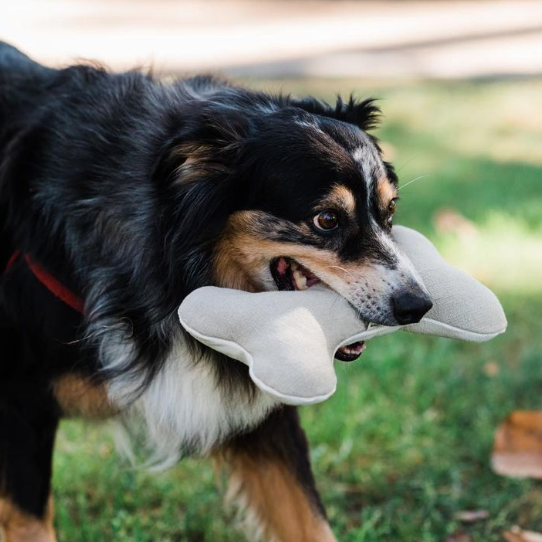Important Note: Before giving your pet any supplement, please always speak with your veterinarian first.
Witnessing our dogs revel in the joy of running, jumping, and playing is what we love most about them. But these carefree moments can be significantly be affected by the onset of hip dysplasia. Canine hip dysplasia is a common orthopedic issue that can significantly impact a dog's quality of life. The condition is characterized by an abnormal hip joint formation and affects various breeds, particularly larger dogs.
As pet parents, we know how hard it is to see your canine companion in any sort of pain. That's why, in this blog, we're delving into the intricacies of canine hip dysplasia, exploring its causes, symptoms, and various treatment options. Specifically, we're placing a particular focus on the emerging role of CBD in treating your dog's hip dysplasia.
Understanding Canine Hip Dysplasia
The hip is a ball and socket joint that should fit and move smoothly with a reasonable level of mobility. Canine hip dysplasia occurs when the hip joint's ball and socket don't fit together properly. This genetic predisposition is often exacerbated by environmental factors, such as rapid growth and improper weight management, leading to instability and degeneration of the joint over time.
Recognizing Symptoms of Hip Dysplasia in Dogs
Hip Dysplasia in dogs is associated with a range of signs and symptoms that dog owners need to be aware of. Sadly, by the time many dogs visits the vet, their activity levels have already dwindled, hindering their ability to leap on the couch or frolic as before - which poses a genuine concern for their overall quality of life.
Hip dysplasia can manifest in dogs as early as four months old or develop with age, often accompanied by osteoarthritis. Additionally, large breed dogs, such as Labrador Retrievers, Golden Retrievers, and German Shepherds, are more susceptible, given their genetics and size.
While the severity of the condition, level of inflammation, joint looseness, and the duration of hip dysplasia can influence symptoms, here are some signs that many dogs with hip dysplasia experience:
-
Awkward running
-
Chronic or occasional frailty
-
Joint sounds like cracking or popping
-
Decreased activity
-
Difficulty navigating objects
-
Difficulty going up or down objects like coaches, cars, and stairs
-
Limping
-
Loss of muscle mass
-
Pain
-
Trouble standing
-
Unusual sitting positions.
Treating Hip Dysplasia in Dogs
Several approaches aim to alleviate the pain and discomfort associated with hip dysplasia, ranging from lifestyle modifications to surgical interventions. Let's take a look.
Non-Surgical Approaches
Weight Management
Proper weight maintenance reduces strain on the hip joints, slowing the progression of dysplasia. You can prioritize weight management by creating a balanced diet and regular exercise tailored to your pet's needs.
Physical Therapy
Targeted exercises can strengthen surrounding muscles, providing better support to compromised hip joints.
Medications
Nonsteroidal anti-inflammatory drugs (NSAIDs) offer pain relief and reduce inflammation, enhancing the dog's comfort.
Surgical Procedures
Triple Pelvic Osteotomy (TPO)
This surgical procedure aims to improve hip joint stability in young dogs by altering the hip socket's angle.
Femoral Head Ostectomy (FHO)
Removing the femoral head can alleviate discomfort and improve mobility in cases of severe pain or joint degeneration.
Total Hip Replacement
This advanced surgical option involves replacing the entire hip joint with prosthetics, offering a long-term solution for severe cases.
Exploring CBD for Canine Hip Dysplasia
Recent trends in veterinary medicine highlight the potential benefits of CBD oil for managing hip dysplasia in dogs. CBD, or cannabidiol, is a non-psychoactive compound derived from the cannabis plant. Research suggests its anti-inflammatory and analgesic properties may contribute to relieving pain associated with hip dysplasia.
What are the Benefits of CBD Oil?
Pain Management
CBD interacts with the endocannabinoid system, regulating pain perception and inflammation. Some studies indicate that CBD oil may offer natural relief for your dog's pain without the adverse effects commonly associated with traditional medications.
Improving Joint Health
CBD's anti-inflammatory properties can potentially improve joint health and reduce joint pain.
Weight Management
CBD may indirectly aid in your dog's weight management by addressing factors like anxiety or pain that could contribute to overeating. That said, a holistic approach to your pet's weight control, including ensuring that your dog's diet is balanced and exercises regularly, is still essential.
Learn about using CBD to calm your dog.
We also have cricket based dog treats for hip and joint health.






